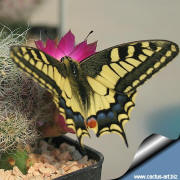| |
The Lepidoptera is one of the
largest order of
insects, which includes
Butterflies, Skippers,
Moths, Leaf Rollers, Hawk-Moths,
Noctuids, Geometers, Processionary, Caterpillars, Coppers, Whites,
Burnets... (The order comprises more
than 180,000 species, second
only to the Coleoptera (the
beetles).
|
|
|

A butterfly the "Common Swallowtail" (a
Lepidoptera of the Papilionoidea family Papilio machaon)
on a flower of
Sulcorebutia gerosenilis |
Lepidopterans go through a four-stage
life cycle of
egg–larva/caterpillar–pupa/chrysalis–imago/adult. Adults (butterflies) have two
pairs of membranous broad wings, covered with minute scales,
commonly brightly coloured. They have a tubular proboscis (mouth
parts) adapted for sucking that - when not in use - can be
coiled up spirally. The mandibles are rudimentary or absent. The adults feed
for the most part on the nectar
of flowers and are important
pollinator. The
larvae, called
caterpillars, are
frequently brightly coloured, and they commonly feed on
leaves and other
plants
organ, many of them are dangerous
herbivorous
parasites and may cause
serious damage in cultivation. |
|
|